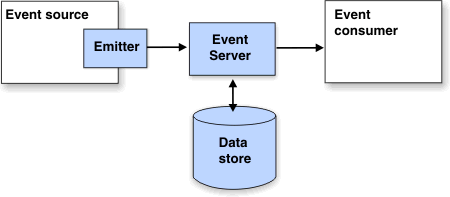IBM BPM, V8.0.1, All platforms > Measuring and improving business processes > Monitoring > Service component monitoring overview
Common Event Infrastructure
Common Event Infrastructure is an embeddable technology intended to provide basic event management services to applications that require those services.
This event infrastructure serves as an integration point for consolidation and persistence of raw events from multiple, heterogeneous sources, and distribution of those events to event consumers. Events are represented using the Common Base Event model, a standard, XML-based format defining the structure of an event. See the Common Base Event model sub-topic.
By using this common infrastructure, diverse products that are not tightly coupled with one another can integrate their management of events, providing an end-to-end view of enterprise resources and correlating events across domain boundaries.
For example, events generated by a network monitoring application can be correlated with events generated by a security application. Such correlation can be difficult to achieve when each product uses its own approach to event management.
Common Event Infrastructure provides facilities for generation, propagation, persistence, and consumption of events, but it does not define the events themselves. Instead, application developers and administrators define event types, event groups, filtering, and correlation.
Common Event Infrastructure components
Common Event Infrastructure consists of the following major components:
- Common Base Event
- The Common Base Event component supports the creation of events and access to their property data. Event sources use the Common Base Event APIs to create new events conforming to the Common Base Event model; event consumers use the APIs to read property data from received events. In addition, applications can convert events to and from XML text format, supporting interchange with other tools. The Common Base Event component is part of the Eclipse Test and Performance Tools Platform (TPTP).
- Emitter
- The emitter component supports the sending of events. After an event source creates an event and populates it with data, the event source submits the event to an emitter. The emitter optionally performs automatic content completion and then validates the event to ensure that it conforms to the Common Base Event specification. It also compares the event to configurable filter criteria. If the event is valid and passes the filter criteria, the emitter sends the event to the event service. An emitter can send events to the event service either synchronously (using Enterprise JavaBeans calls) or asynchronously (using a Java™ Message Service queue).
- Event service
- The event service is the conduit between event sources and event consumers. The event service receives events submitted to emitters by event sources. It stores events in a persistent data store, and then distributes them asynchronously to subscribed event consumers. In addition, the event service supports synchronous queries of historical events from the persistent store.
- Event catalog
- The event catalog is a repository of event metadata. Applications use the event catalog to retrieve information about classes of events and their permitted content.
In addition, an application or solution using Common Event Infrastructure might also include the following components (which are not part of the infrastructure itself):
- Event source
- An event source is any application that uses an emitter to send events to the event service.
- Event consumer
- An event consumer is any application that receives events from the event service.
- Event catalog application
- An event catalog application is any application that stores or retrieves event metadata in the event catalog. This might be a management or development tool; it might also be an event source or event consumer.
The following diagram shows the general flow of events from event source to event consumer using Common Event Infrastructure.
